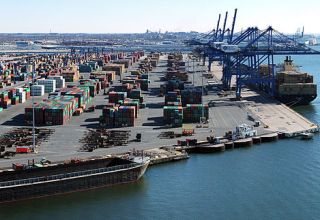 The Far East-Europe trading lane is today’s main battlefield for carriers, but the battlefield of tomorrow will be the Far East-U.S. East Coast (USEC), forecasts BIMCO in a new report.
The Far East-Europe trading lane is today’s main battlefield for carriers, but the battlefield of tomorrow will be the Far East-U.S. East Coast (USEC), forecasts BIMCO in a new report.
The Far East-to-Europe lane recorded a demand growth of 8 percent in the first seven months of the year compared to the same period last year, with August contributing further to a strong year, coming in 8.6 percent higher than August 2013.
“Knowing the sad state of the European economies, unfortunately, such a strong increase in demand appears to originate more from inventory restocking than anything else,” said BIMCO.
Still, it added, the strong demand has brought down the number of idle ships and eased the integration of newbuilt ultra-large container ships (ULCS) into the trading lane.
At the same time, freight rates have been firm until the start of the peak season, when the market appeared “awash with tonnage,” bringing freight rates down.
“The recent Golden Week holiday in China has caused supply to contract to meet the new level of demand. It remains to been seen whether the next round of general rates increases can turn the tables once more and bring about higher freight rates,” said BIMCO.
It sees more promise on the Far East to U.S. East Coast trading lane, where “we have seen a very steady freight rate level improve going into the peak season.” It said rates hit a new record-high on August 1 of US$4,187 per forty-foot unit, then peaked at $4,636 per FEU a month later.
The global shipping association cites several reasons for identifying the Asia-USEC lane as the battlefield of the future.
- Expansion of the Panama Canal to service container ships up to 13,000 TEUs from 2016.
- Enlargement of Suez Canal started only a couple of months ago.
- Heightening of the Bayonne Bridge to allow ULCS to call New York/New Jersey.
- Ongoing delivery of ULCS is likely to introduce some of the cost-effective ULCSs on this long-haul trade to reap the economics of scale, beyond the preferred trade for them which is Far East to Europe.
- Expansion of other U.S. East Coast ports that allows them to receive the giant vessels in future, by dredging and introducing larger “Super-Post-Panamax” cranes.
“The volume growth is already there with much room for expansion,” said the report. “Time will tell how that trade will develop.”
Fleet growth forecast
Meanwhile, BIMCO noted that efforts by liner companies to mitigate supply during the last two to three years have been derailed somewhat over the past two months.
The overall fleet has grown by 4.9 percent in the year so far, and is on track to grow faster this year than in 2013 on an annualized basis.
The demolition of non-competitive ships, which has been brisk in the first seven months, has cooled down promptly in August/September from a monthly average of 43,618 TEUs from January to July to a monthly average of just 14,569 TEUs in the most recent two months.
This, it noted, indicates that demolition going forward may not be as strong as it has been this year and the year before. Year-to-date scrapping now amounts to 335,000 TEUs.
Moreover, “investors have lost their cool,” it said, as ships with a combined capacity of 254,000 TEUs have been ordered in the past six weeks. Of these, 15 are ULCVs in the region of 13,780-19,200 TEUs and 12 are small feeders, with an average size of 1,327 TEUs.
Looking ahead, BIMCO estimates a four-year-high fleet growth level for 2015, as long as the delivery of newbuildings keeps surging while demolition is set to ease off.
CMA CGM deploys Elbe
Meanwhile, CMA CGM has launched the 9,400-TEU CMA CGM Elbe on its maiden voyage on October 14 in Dalian, China.
The CMA CGM Elbe is the second of a series of 28 vessels from 9,400 TEUs to 10,900 TEUs in size, vessels which will be delivered from now to the third quarter of 2016. Last June, the group received the delivery of the first vessel of this series, the CMA CGM Danube.
Sailing under the Malta flag, Elbe is the second chartered ship of this class built at the Chinese construction site DSIC.
Measuring 300 meters in length and 48 meters in width, the Elbe was designed to offer maximal loading capacity while meeting the technical constraints necessitated by the Strait of the Bosphorus.
Operated on one of the emblematic lines of the group, the Bosphorus Express, the Elbe will offer direct service between Asia, Turkey and the Black Sea. Accordingly, it will call Dalian, Tianjin, Kwangyang, Busan, Shanghai, Ningbo, Chiwan, Yantian, Tanjung Pelepas, Izmit, Istambul Ambarli, Constanza, Odessa, Ilyichevsk, Port Said, Port Klang, Singapore, and once again Dalian.
Photo: fatlouie




